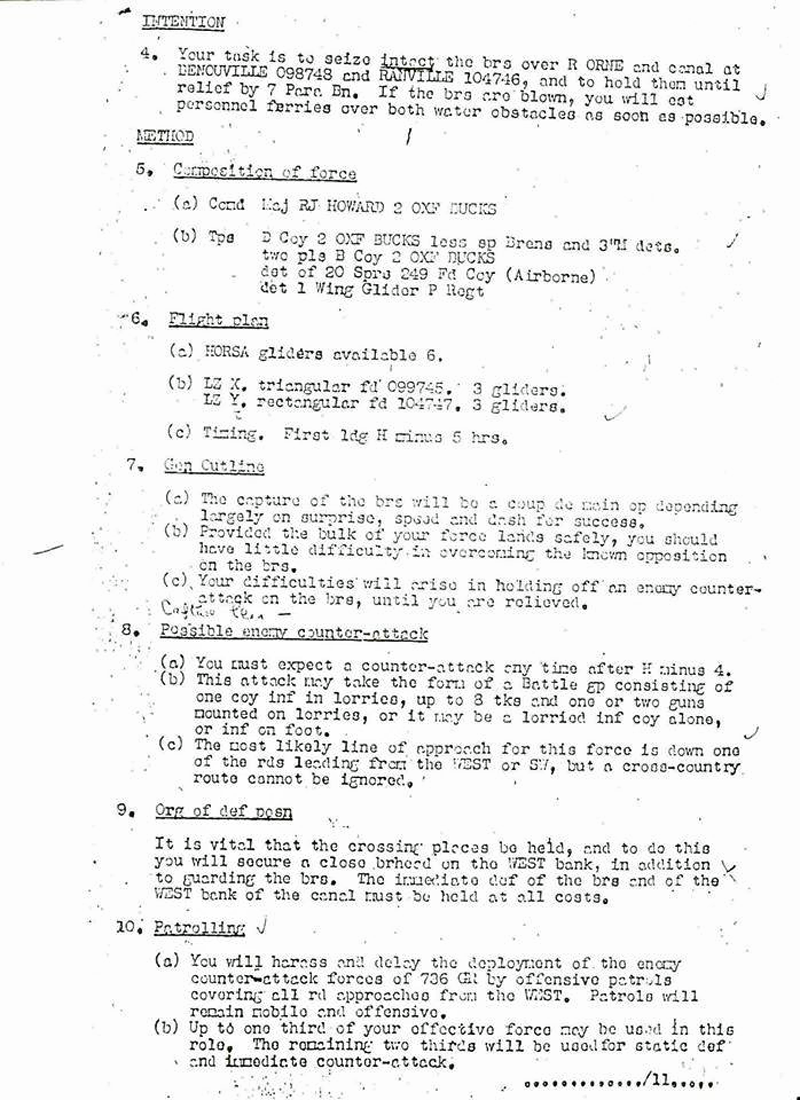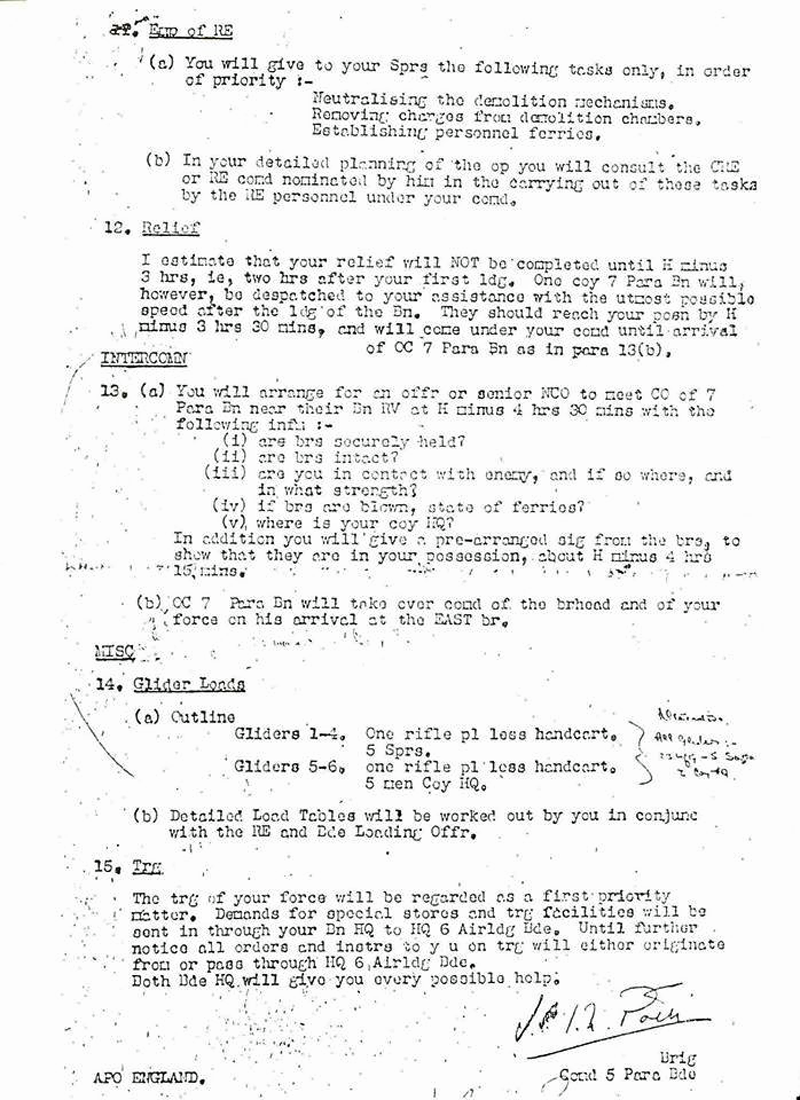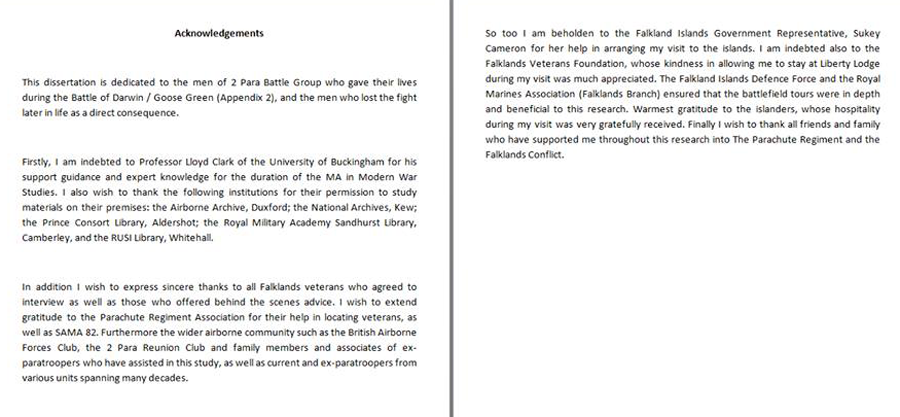The 2nd Parachute Battalion formed at Hardwick in Derbyshire from volunteers across the Army in September 1941 under Lt Col Flavell.
C Company under Major JD Frost conducted the second British parachute raid of the war on 27th February 1942 against a German radar installation at Bruneval on the Channel coast in France. Vital radar components and German technicians were captured and the group successfully taken off by the Royal Navy. This was the first battle honour awarded to the newly formed Parachute Regiment and reaffirmed Prime Minister Churchill’s belief in the future of airborne forces.
The Battalion departed for North Africa with the 1st Parachute Brigade and dropped at Depienne on 29th November 1942. Frost was the Battalion Commander this time and the objective was Oudna, nine miles from Tunis. This was briefly achieved but unexpectedly heavy German resistance prevented the link up with the advancing 1st Army and the 2nd Battalion was isolated 56 miles behind enemy lines. Attacked by German air and armour Frost conducted a fighting withdrawal to regain the Allied lines, losing 16 officers and 250 men en route. During the next five months to April 1943 the battalion fought through the winter as line infantry. Oudna became a Parachute Regiment battle honour.
The 2nd Battalion dropped with the 1st Parachute Brigade during the hard fought costly attempt to secure the Primosole Bridge in Sicily on 13th July 1943; it also participated in the later sea landings and fighting around Taranto in Italy the following September. In November the battalion returned to the UK with the 1st Airborne Division.
During Operation MARKET-GARDEN the 2nd Battalion dropped at Arnhem on 17th September 1944 and with Recce and Airborne Engineers and some 3rd Battalion soldiers, captured the road bridge. The force was soon cut off but held its ground against incessant German tank and infantry attacks for three days and four nights. The division objective was to hold for 48 hours before being relieved by the advancing XXX Corps, which never arrived. By dusk on 20th September Lt Col Frost was wounded and his Battalion reduced to a few survivors ordered to break out. Lt John Grayburn with A Company was awarded a posthumous VC.
The River Orne and Caen Canal Bridges
The seizing of the two bridges near Bénouville was to be carried out by a specially trained and reinforced gliderborne infantry company, D Company of the 2nd Oxfordshire and Buckinghamshire Light Infantry commanded by Major John Howard. They were to be the first Allied unit into action on D-Day and they were to seize the bridges by a coup de main assault. Once the bridges had been captured they were to be reinforced by the British 7th (Light Infantry) Parachute Battalion commanded by Lieutenant Colonel Geoffrey Pine-Coffin who were to drop onto DZ ‘NAN’ a couple of miles to the east of the River Orne Bridge.
At 00.16 hrs the first of the six Horsa gliders carrying Major Howard’s coup de main force landed at the Caen Canal Bridge. The pilot S/Sgt Jim Wallwork put the glider down onto the bumpy LZ perfectly and it came to rest in the corner closest to the bridge with its nose through the wire defences. The men of D Company dismounted and attacked. Within ten minutes both bridges had been captured and about an hour later the 7th Parachute Battalion arrived to reinforce the position. Throughout the night and the following morning the British Airborne at the bridges fought off repeated counterattacks until British soldiers coming up from SWORD Beach finally relieved them.

With their primary D-Day tasks accomplished the British 6th Airborne Division set about securing the eastern flank of the invasion area, a task that they continued to carry out in the weeks following the invasion.

Many thanks to Norman McKay for providing the above. It is signed by Major John Howard and was sent to my son Alasdair when he wrote his University entrance Exam "HAM & JAM".

On 6 June 1944, the 7th Parachute Battalion landed in Normandy. Many men of the battalion were scattered or landed on the wrong drop zone. So badly scattered were they that, by 03:00, Lieutenant Colonel Pine-Coffin in command had only around forty percent of the battalion at the forming up point, although men continued to appear throughout the day. Relatively few of their supply containers had been found, meaning that they possessed few heavy weapons or radio sets. However, the battalion managed to rendezvous with the coup-de-main forces of the 2nd Battalion, Ox and Bucks Light Infantry at the Caen and Orne bridges.
They then set up a defensive perimeter against German counter-attacks. The first German assault on the bridges came between 05:00 and 07:00 and consisted of isolated and often uncoordinated attacks by tanks, armoured cars and infantry, which grew in intensity throughout the day. The Luftwaffe attempted to destroy the Caen bridge with a 1,000 lb (450 kg) bomb, which failed to detonate, and two German Navy coastal craft, which attempted to attack the bridge, were also repelled. Despite the ferocity of the attacks, the battalion and the coup-de-main forces were able to hold the bridges until 19:00, when leading elements of the 3rd British Infantry Division arrived and began to relieve the battalion. By midnight, the battalion was being held in reserve behind the 12th Parachute Battalion occupying Le Bas de Ranville and the 13th Parachute Battalion holding Ranville.
Operation Musketeer
Operation Musketeer
was the invasion of Suez in 1956, a joint British, French and Israeli operation. The immediate cause was Nasser nationalizing the Suez Canal. It was a military success and a political failure. All three of our regular battalions were there. 3 PARA jumped in. 1 PARA & 2 PARA went by sea so they missed out on the first and last operational jump since World War
II ... Interesting website http://sunray22b.net.
After the war the under-strength 2nd Battalion deployed to Palestine was amalgamated on 13 December 1947 with the 3rd Battalion to form the 2nd/3rd Parachute Battalion, which was disbanded the following year. A new 2 PARA was formed in July 1948 from the 5th (Scottish) Parachute Battalion.
The battalion deployed for internal security operations with the 16th Parachute Brigade to the Canal Zone in Egypt during 1951-4. In July 1956 2 PARA was conducting anti-terrorist operations against EOKA in Cyprus and in November it participated in the sea-borne landings at Port Said during the Suez Crisis. Then in July 1958 it flew into Amman Jordan as part of the 16th Parachute Brigade intervention force.
Once again in June 1961 2 PARA formed part of a strategic reserve ‘fire-brigade’ deployment, this time to Kuwait to deter an Iraqi invasion threat. Alongside other British reinforcements the battalion occupied the Matla Ridge astride the main Iraqi tank route to Kuwait City. Subsequent deployments to the island of Bahrain followed in 1963, 64 and 67. D Company Group was stood by during the Communist uprising in Zanzibar but was never employed.
In early 1965 the Battalion was flown to Singapore for jungle training and established jungle bases on the border against Indonesia during its confrontation with the newly established Federal Malaysia. C Company converted to a special patrols company operating in the jungle on SAS lines. An Indonesian Javanese battalion attacked the B Company base at Plaman Mapu on 27th April and was repelled, suffering 50 casualties at a cost of two paratroopers killed and seven wounded; the biggest battle of the confrontation.
In 1968 2 PARA deployed to Hong Kong after jungle training for a six month tour to counter illegal immigration from the People’s Republic of China. Another unexpected tour to the Island of
Anguilla
occurred in 1969 to quell political unrest over federation with other Caribbean states. A successful ‘hearts and minds’ operation resulted in the award of the
Wilkinson Sword of Peace ‘for acts of humanity and kindness overseas’.
The first Northern Ireland tour started in February 1970 when the Battalion was deployed to the Shankhill Road district of Belfast. 2 PARA was to spend 114 months in Northern Ireland across 16 tours conducted between 1970 to 2002, longer than any other Parachute Battalion. It also suffered the greatest single loss of life during a double PIRA ambush at Warrenpoint on 27th August 1979, when a company commander and 15 soldiers were killed in one incident. Operation
Motorman (start) Operation Motorman was a large operation carried out by the British Army in Northern Ireland during the Troubles. The operation took place in the early hours of 31 July 1972 with the aim of retaking the "no-go areas" (areas controlled by Irish republican paramilitaries) that had been established in Belfast, Derry and other large towns.
Background
The Northern Ireland riots of August 1969 marked the beginning of the conflict known as "The Troubles". As a result of the riots, Northern Ireland's two main cities—Belfast and Londonderry—had become more segregated than before. Many neighbourhoods became either purely Irish nationalist and republican or purely unionist and loyalist. In some places, residents and paramilitaries built barricades to seal-off and protect their neighbourhoods from incursions by "the other side", by the security forces, or both. These became known as "no-go areas".
By the end of 1971, 29 barricades were in place to block access to what was known as Free Derry; 16 of them impassable even to the British Army's one-ton armoured vehicles.
Many of the nationalist/republican "no-go areas" were controlled by one of the two factions of the Irish Republican Army—the Provisional IRA and Official IRA. On 29 May 1972, the Official IRA called a ceasefire and vowed that it would only launch attacks in self-defence.
On 21 July 1972, in the space of 75 minutes, the Provisional IRA detonated 22 bombs in Belfast. Nine people (including two soldiers and a loyalist paramilitary) were killed and 130 were injured. This attack prompted the British Government to implement Operation Motorman, just ten days later.
Preparations
Operation Motorman would be the biggest British military operation since the Suez Crisis of 1956, and the biggest in Ireland since the Irish War of Independence. In the days before 31 July, about 4,000 extra troops were brought into Northern Ireland. Involved were almost 22,000 soldiers—including 27 infantry and two armoured battalions—aided by 5,300 soldiers from the local Ulster Defence Regiment (UDR). Several Centurion AVRE demolition vehicles, derived from the Centurion tank, were used. These were the only heavy tanks to be deployed operationally by the British Army in Northern Ireland during the Troubles. The tanks had been transported to Northern Ireland on board the amphibious landing ship HMS Fearless, and were operated with their main guns pointed to the rear, covered with tarpaulins.
This quick military build-up alerted the Provisional IRA and Official IRA that a major operation was being planned.
The operation
The operation began at about 4:00am on 31 July and lasted for a few hours. In "no-go areas" such as Free Derry, sirens were sounded by residents to alert others of the incursion. The British Army used bulldozers and the Centurion AVREs to smash through and dismantle the barricades, before flooding the "no-go areas" with troops in armoured vehicles. The Provisional IRA and Official IRA were not equipped to battle such a large force and did not attempt to hold their ground. Small scale operations were carried out in other places like Lurgan, Armagh, Coalisland and Newry. By the end of the day, Derry and Belfast had been cleared of "no-go areas", but the Army remained cautious when operating in staunchly republican districts.
Operation Motorman (end)
New colours were presented to the Battalion with the other regular battalions and 4 PARA in 1974. Between 1977-9, 2 PARA was posted to Berlin, followed by a two- year residential tour in Ballykinler in 1979-81. Op BESSEMER.
In August 2 PARA were deployed with 16 Air Assault Brigade to Macedonia on Op BESSEMER. After growing tensions in FYROM between the ethnic Albanian National Liberation Army (NLA) and the Macedonian Army (ARM), a NATO brokered peace agreement was signed between the two parties.
HQ 16 Air Asslt Bde became HQ Task Force Harvest with a multinational force of 15 nations under command. Their mission was to deploy to collect and dispose of NLA weapons and ammunition in order to restore stability in the FYROM. As the NLA operated primarily in the mountains of Western Macedonia, the terrain was eminently suitable for “light” operations. 2 PARA took under command 9 Para Sqn RE and the Dutch “Kings” Coy for all missions. An Italian Mechanised Sqn was also placed under command for the third mission to Brodec . B Company also conducted missions with the French 2 REI, and C (Gurkha) Company independent missions with the Harvest Liaison Teams (Special Forces) . 2 PARA successfully conducted 3 major arms collection operations and then recovered to UK on 12 October.
More
by Paradata Editor
The Battalion embarked for the Falkland Islands conflict on 26th April 1982 aboard the North-Sea car ferry MV Norland and was ashore on Sussex Mountain by 22nd May, securing the southern part of the 3 Commando Brigade bridge-head. On 28th May 2 PARA attacked the Argentinean strategic reserve and airfield on the Darwin/Goose Green Peninsular. Over 1,250 prisoners were taken and 50 Argentineans killed during this bloody battle that cost the Battalion 15 dead, including its Commanding Officer Lt Col ‘H’ Jones, who was awarded a posthumous VC. Bluff Cove and Fitzroy were captured by the Battalion which fought its final battle at Wireless Ridge during the night of 13/14th June. 2 PARA was among the first troops to enter Port Stanley following the Argentinean surrender.
This dissertation is dedicated to the men of 2 Para Battle Group who gave their lives during the Battle of Darwin / Goose Green and the men who lost the fight later in life as a direct consequence.

To follow this from Jade White MA ... please click here
In 1983 the battalion served a six month tour in Belize, to deter a threatened Guatemalan invasion and came back in 1987-8. The barracks at Tern Hill were bombed by the PIRA in 1989 and the Battalion was committed to five Op BANNER and residential Northern Ireland tours in the 1990s.
2 PARA was the first battalion to move to Colchester to co-locate with the newly formed
16th Air Assault Brigade and completed two more Northern Ireland tours between 2000 and 2002. This was followed by two
Operation TELIC tours - 3 and 7 - in Iraq in 2005 and 2007.
In the Spring of 2008 2 PARA formed the nucleus of a 16th Air Assault Brigade 1,150 strong all-arms Battle Group in Helmand Province Southern Afghanistan, during Op HERRICK VIII, returning in the Autumn.
In late September 2010, 500 men of 2 PARA returned to Afghanistan as part of the 16 Air Assault Brigade force for HERRICK 13.
Northern Ireland Tours:
Op BANNER Feb-Jun 70 4 Months
Op BANNER Apr-Aug 71 4 Months
Op BANNER Feb-Jun 72 4 Months
Op BANNER Jul-Oct 72 4 Months
Op BANNER Mar-Jul 73 4 Months
Op BANNER May-Sep 75 4 Months
Op BANNER Nov 76-May 77 6 Months
Residential Jul 79-Mar 81 20 Months
Op BANNER Oct 84-Mar 85 5 Months
Op BANNER Mar-Jun 90 4 Months
Op BANNER Jun-Oct 92 4 Months
Residential Jul 93-aug 95 25 Months
Op BANNER Sep 96-Mar 97 6 Months
Op BANNER Dec 98-Jun 99 6 Months
Op BANNER (NIBAT) Dec 2000- Jun 01 6 Months
NIBAT 1 Sep 02-May 03 8 Months
|
![[ Sgt Michael Willetts & Sgt Walter Beard ]](Para_Logo.gif)
![[ Cap Badge ]](Wings.gif)